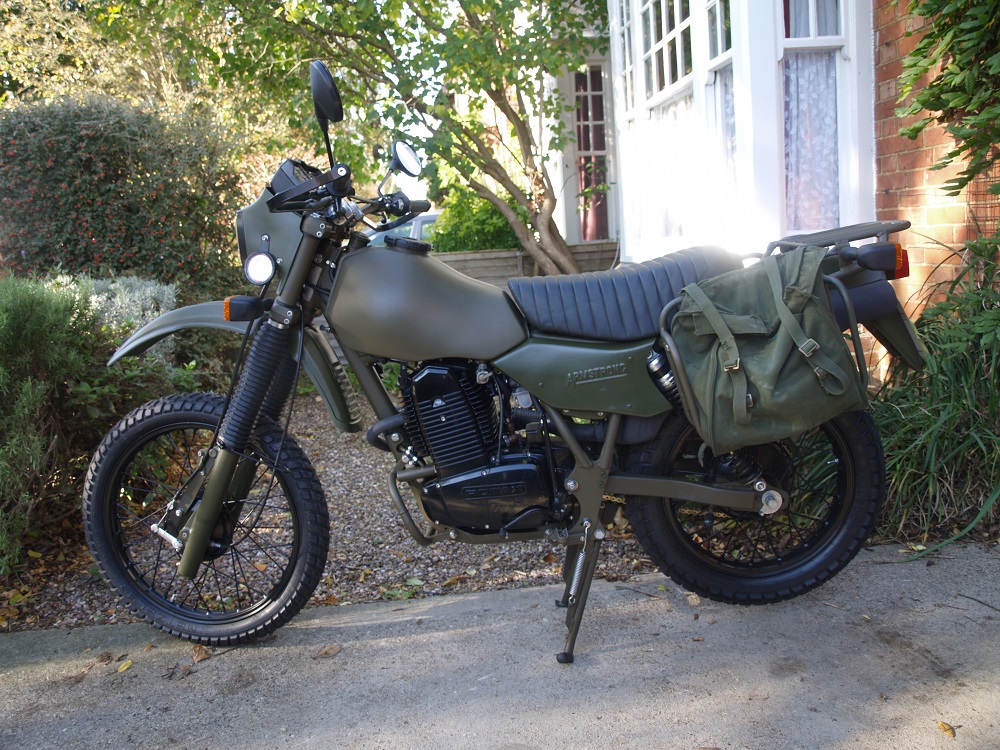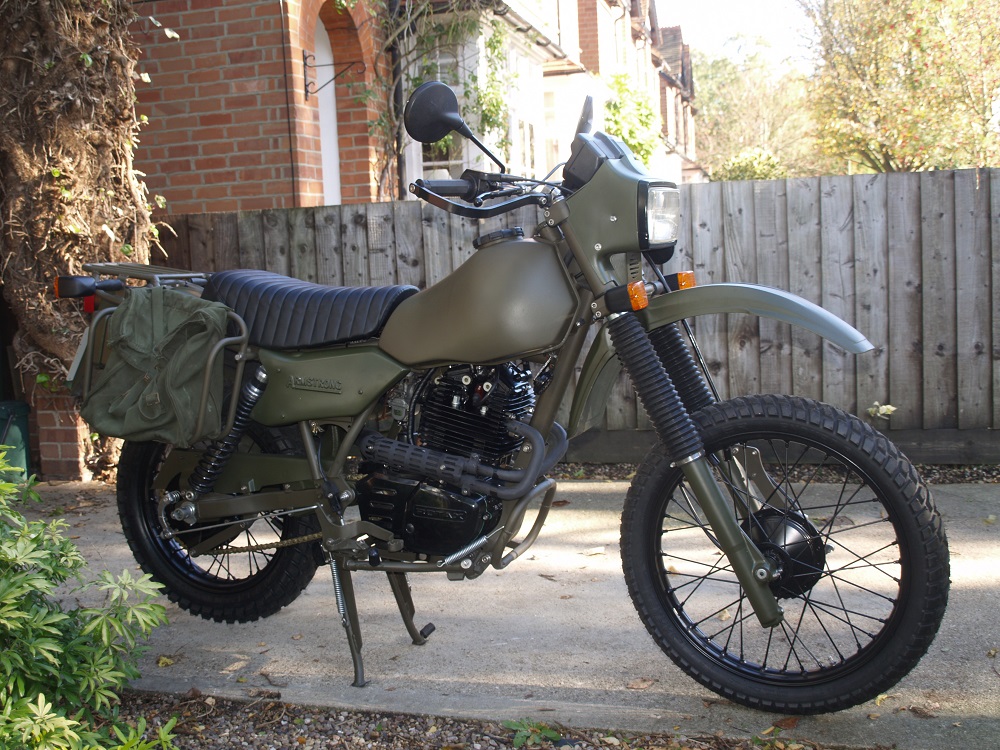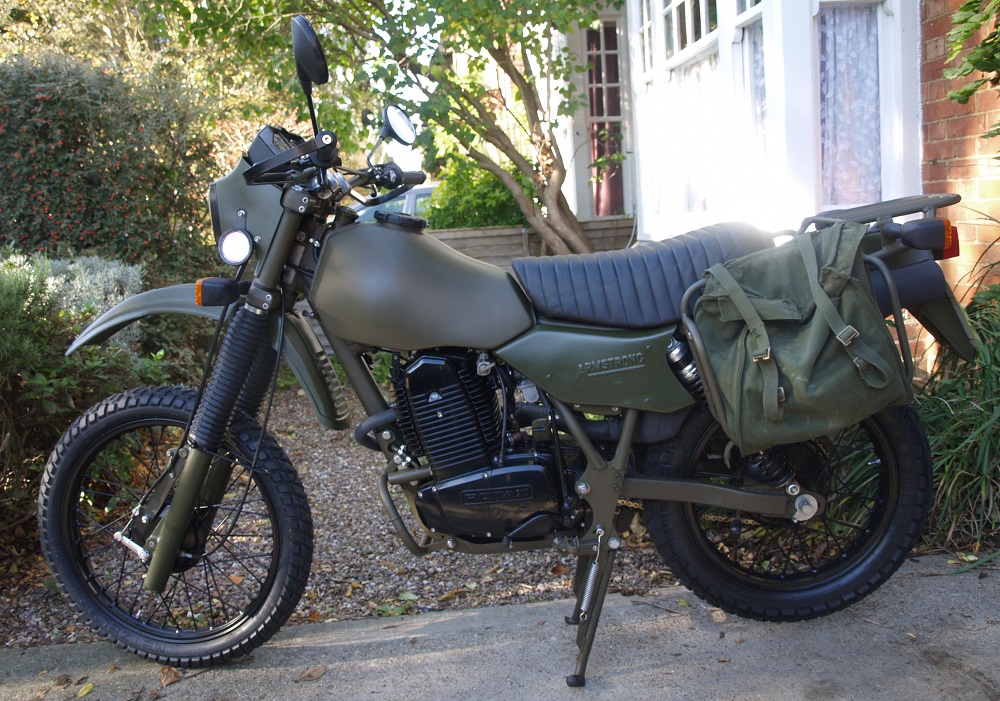The history of Armstrong motorcycles is provided on a separate page. The Armstrong MT500 uses a kickstart version of the Austrian built Rotax 504 cc single cylinder, 4-valve overhead camshaft engine producing 28 bhp and 36 Nm of torque. Although slightly heavy at 162 kg for off-road use, it is a robust motorbike and is fitted with good quality Marzocchi front forks and Ohlin rear shock absorbers. The wheel rims were made by Akront and the hubs by Grimeca. Overall, the bike is well made from an engineering point of view with needle roller swinging arm bearings and taper roller head bearings.
The Rotax engine fitted to the Armstrong is fairly bullet proof although the use of a rubber camshaft timing belt mounted inside a metal cover makes the engine sound slightly agricultural at times. This is made more noticeably by the standard silencer, which does a very good job of suppressing the exhaust sound as required on military machines. In fact, the main noise made by the bike when its performance is being pushed hard is the induction sound from the air filter box which, surprisingly, is quite a satisfying noise.
The engine is powered via a Capacitor Discharge Ignition (CDI) unit direct from the generator and is independent of the battery and the lighting system. The power for the lights and other electrical components then comes from separate alternator coils. A blackout switch is fitted on the handlebar to enable the lights to be distinguished quickly.
One of the weak points on the Armstrong MT500 is its 5.5″ front drum brake, which though adequate for off-road use, does not give a great deal of confidence on public roads. Surprisingly, the rear brake drum is larger at 6″ than the front and is more than adequate for normal use.
Although the original SWM XN Tornado was fitted with a Dellorto carburettor, the MT500 was fitted with an AMAL Mk 2 Concentric which was considered to be a poor choice and caused starting difficulties. Most owners have since replaced them with Mikuni or Dellorto carburettors. Starting the Armstrong MT500 has always been a definite art that has to be learned especially since the kickstart is on the left-hand side of the machine. However, provided the engine and carburettor are properly maintained and set up, the MT500 will start reliably first or second kick although stalling it at traffic lights can still be a humiliating experience!
The MT500 is fitted with pannier racks and bags mounted on the rear sub-frame which are very useful for carrying a wide range of items, including tools and spare Jerry Cans of fuel. Their downside is that they make getting off the bike more difficult especially for older riders. After parking up my bike on one occasion, I caught my foot on one of the pannier racks and, after falling backwards, severely damaged my shoulder requiring surgery to put it right. Since then, getting off the bike has always been the most difficult aspect of owning the bike and must always be done, in my case, with the bike on the sidestand.
The MT500 has a 13 L petrol tank and, with the original AMAL carburettor, was capable on a good day of 53 mpg and a range of about 150 miles. However, although the Mikuni VM carburettor used as an alternative provides good output power from the engine, petrol consumption always seems to be much poorer and can be up to 10 mpg worst than with the AMAL
My MT500 Restoration
As was the case with my Harley Davidson MT350, my MT500 was also bought from someone who lived in Neath in South Wales. I was very dubious initially in looking to buy an MT500 because, at the time, I knew very little about them and, in some ways, it appeared to be a bit of a rough looking type of motorcycle. However, the test ride I did in Neath definitely changed my mind and I became a convert almost straightaway.
The bike was in pretty shoddy condition when I bought it and I therefore gave it a complete nuts and bolt restoration. The frame and fittings and the petrol tank were all powder coating in NATO Green and then, after repair where necessary, the plastic furniture was spray painted in NATO Green. Both wheels were powder coated in satin black and then the inner tubes and Sahara 3 tyres replaced by new items.
All the bearings in the bike were replaced which included the wheel hubs, swing arm and steering head. Similarly all the seals were replaced where necessary. All the control cables were replaced as was the rear chain. The wiring was repaired where necessary and the indicators, which were in battered condition, were replaced. The mirrors were replaced and the seat recovered.
The original engine ran reasonably were but was re-painted and given a top end overall. The only problem found over time with this engine was a tendency to weep oil from somewhere on the cylinder head which made its presence seen on the fins either side of the spark plug. Although the head was removed and checked carefully, it was impossible to find the source of the weeping oil. In frustration, I eventually bought a replacement engine and, after overhauling it, I never had any further trouble from oil leaks.
By way of a footnote, I took the old engine apart to use for spares for the engine in my Armstrong MT560. Although I thought the bottom end of this MT500 engine was sound, when I took it apart I found quite a lot of the bearings in the bottom of the crankcase to be in very poor condition. This showed that, although an engine can appear to run well without any obvious problems, you can never be sure what the actual condition of the internal parts are unless you take it apart and examine them carefully.


MT500 Performance
The Mikuni VM32 carburettor was from Allens and had been fitted by the previous owner. This came jetted with a 185 main jet but this appeared to make the engine run very rich with a standard air filter set up. I therefore tested the bike with a range of main jet sizes and in the end I found a 175 jet was optimum in terms of performance.
Starting an MT500 is always a big topic of conservation and it takes a lot of experience to understand the foibles of the Rotax engine and to get to a point where it can be started reliably. The breakthrough in my understanding was when I realised the engine did not like to be flooded and every precaution had to be taken to avoid this. Once flooded, the engine will simply not start and has to be cleared by turning off the petrol, pressing the decompressor lever and then kicking the bike over half a dozen times before trying to start it again. Mine also did not like the petrol tap being left on after the engine had been stopped for a short period; for example, when filling up at a petrol station. Once all these peculiarities had been learnt, I subsequently never had a problem starting it reliably . However, stalling it at traffic lights was still a potential nightmare because, being brought up on old British kickstart bikes, I have never been able to master kicking a bike over with my left leg.
My Armstrong MT500 was always a joy to ride (now superseded by my Armstrong MT560) . With a power output of around 28 hp, the performance of the MT500 is very good for a bike of this size and will cruise comfortably at 70 mph. At 36 Nm of torque, the MT500 also has reasonably good acceleration and, typical of a large single cylinder motorcycle, produces the maximum torque without the need to rev the engine hard. Like most MT500’s, mine is fitted with a replacement Mikuni carburettor which gives good performance from the engine but at the expense of fuel consumption. On a good day, mine will only do 42 mpg significantly reducing the range with a tank load of fuel.
MT500 Specifications
- Engine: Single cylinder, SOHC, 4-valve, 4-stroke
- Starting: Kickstart only
- Capacity: 481 cc
- Bore/Stroke: 89 x 77.4 mm
- Compression Ratio: 8.2:1
- Max Power: 28 bhp
- Max Torque: 36 Nm
- Carburettor: AMAL Mk 2 Concentric
- Cooling: Air cooled
- Lubrication: Dry sump
- Ignition: CDI with magnetic pick-up
- Transmission: 5 speed
- Final Drive: Chain
- Front Suspension: Marzocchi oil filled with 270 mm travel
- Rear Suspension: Ohlins nitrogen filled 230 mm travel
- Front Brake: 140 mm drum brake
- Rear Brake: 150 mm drum brake
- Rake/Trail: 25 deg and 92 mm
- Wheel Base: 1.4 m
- Seat Height: 855 mm
- Front Tyre: 90/90-21
- Rear Tyre: 4.00-18
- Ground Clearance: 220 mm
- Dry Weight: 161 kg
- Fuel Tank: 13 L
- Oil Tank: 3.2 L
MT500 Parts Suppliers
There are two very good suppliers of spare parts for both the Armstrong MT500 and the later Harley-Davison MT350: Force Motorcycles near Burton-on-Trent and LMS near Litchfield.
23,197 total views, 1 views today


